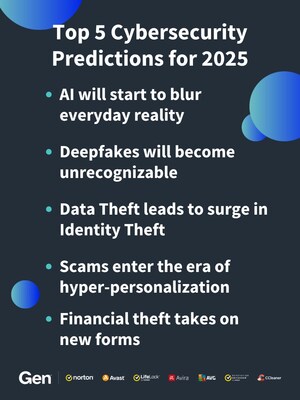Understand the latest cyber attacks and how to prevent them.
Understand the latest cyber attacks and how to prevent them.
Blog Article
The Following Frontier: Insightful Cybersecurity Predictions for the Coming Year
As we approach the brand-new year, the cybersecurity landscape is on the brink of significant change. Trick variables such as the assimilation of sophisticated AI technologies, the inevitable rise of sophisticated ransomware, and the firm of data privacy laws are shaping the future of digital safety and security. The recurring frequency of remote work proceeds to subject brand-new susceptabilities that companies must navigate. Comprehending these dynamics is essential for anticipating the obstacles ahead and tactically strengthening defenses, yet the ramifications of these modifications continue to be to be totally discovered.
Surge of AI in Cybersecurity
In the quickly advancing landscape of cybersecurity, the assimilation of man-made intelligence (AI) is emerging as a crucial force in improving danger discovery and action capabilities. AI innovations, such as artificial intelligence formulas and deep knowing versions, are being increasingly deployed to assess substantial amounts of information and identify patterns a sign of security hazards. cybersecurity and privacy advisory. This enables organizations to proactively address susceptabilities prior to they can be made use of
The increase of AI in cybersecurity is particularly considerable in its capacity to automate regular jobs, enabling human experts to concentrate on even more complicated safety and security problems. By leveraging AI, cybersecurity teams can decrease action times and improve the accuracy of hazard evaluations. Furthermore, AI systems can adjust and pick up from new risks, constantly refining their detection systems to remain ahead of destructive stars.
As cyber hazards end up being extra sophisticated, the need for advanced options will certainly drive further financial investment in AI modern technologies. This trend will likely cause the development of boosted safety devices that incorporate predictive analytics and real-time monitoring, eventually strengthening business defenses. The change towards AI-powered cybersecurity solutions represents not simply a technical change however an essential adjustment in just how organizations approach their protection strategies.
Boost in Ransomware Attacks
Ransomware assaults have actually become a common danger in the cybersecurity landscape, targeting organizations of all sizes and across various sectors. As we progress into the coming year, it is anticipated that these strikes will certainly not just raise in regularity but also in class. Cybercriminals are leveraging innovative tactics, including the usage of expert system and device knowing, to bypass conventional protection procedures and manipulate vulnerabilities within systems.
The acceleration of ransomware attacks can be attributed to numerous elements, consisting of the increase of remote job and the expanding reliance on electronic solutions. Organizations are often not really prepared for the advancing danger landscape, leaving crucial infrastructure vulnerable to breaches. The economic ramifications of ransomware are staggering, with companies encountering substantial ransom money needs and possible long-term operational disturbances.
Furthermore, the pattern of double extortion-- where enemies not just encrypt data but likewise threaten to leakage sensitive details-- has gained traction, better coercing targets to abide by needs. Because of this, businesses should prioritize robust cybersecurity steps, including normal backups, employee training, and event reaction preparation, to minimize the dangers related to ransomware. Failure to do so can lead to devastating consequences in the year in advance.
Advancement of Data Privacy Rules
The landscape of data personal privacy regulations is undertaking significant change as federal governments and organizations reply to the increasing worries surrounding personal data security. Over the last few years, the execution of thorough structures, such as the General Information Defense Regulation (GDPR) in Europe and the California Customer Personal Privacy Act (CCPA) in the United States, has established a precedent for more stringent personal privacy regulations. These guidelines emphasize consumers' rights to regulate their data, mandating openness and accountability from organizations that gather and refine individual information.

Furthermore, companies will certainly need to improve their conformity methods, investing in sophisticated technologies and training to safeguard delicate info. The development of information personal privacy policies will not just influence just how organizations run yet also shape consumer assumptions, fostering a society of visit homepage trust and safety and security in the digital landscape.
Growth of Remote Job Vulnerabilities
As companies proceed to welcome remote job, vulnerabilities in cybersecurity have progressively pertained to the center. The shift to flexible work arrangements has actually exposed critical gaps in safety methods, especially as employees accessibility sensitive data from varied locations and tools. This decentralized job environment produces an expanded assault surface area for cybercriminals, who make use of unsecured Wi-Fi networks and individual devices to infiltrate company systems.

To minimize these susceptabilities, companies should focus on comprehensive cybersecurity training and execute durable protection frameworks that incorporate remote work scenarios. This consists of multi-factor verification, regular system updates, and the establishment of clear procedures for information accessibility and sharing. By dealing with these vulnerabilities head-on, business can foster a more secure remote work environment while keeping functional resilience when faced with progressing cyber risks.
Advancements in Threat Detection Technologies


Positive hazard detection has become a foundation of contemporary cybersecurity methods, showing the immediate requirement to neutralize progressively innovative cyber risks. As organizations encounter an advancing landscape of vulnerabilities, developments in danger discovery innovations are critical in mitigating threats and enhancing safety postures.
One noteworthy pattern is the integration of expert system and artificial intelligence into hazard detection systems. These innovations make it possible for the analysis of large amounts of information in real time, allowing for the recognition of anomalies and possibly malicious activities that may evade conventional learn the facts here now protection actions. Additionally, behavioral analytics are being implemented to establish baselines for typical customer task, making it easier to spot inconsistencies a sign of a breach.
Moreover, the increase of automated risk knowledge sharing platforms helps with collaborative protection initiatives throughout sectors. This real-time exchange of details improves situational awareness and speeds up response times to arising dangers.
As organizations proceed to buy these advanced modern technologies, the effectiveness of cyber defense reaction will dramatically improve, empowering safety and security teams to remain one action in advance of cybercriminals. Ultimately, these improvements will certainly play an essential role fit the future landscape of cybersecurity.
Conclusion
In recap, the approaching year is expected to witness transformative growths in cybersecurity, driven by the combination of AI technologies and a remarkable increase in ransomware attacks. As information privacy laws come to be a lot more strict, organizations will certainly need to enhance check my site compliance methods. The recurring challenges presented by remote job susceptabilities necessitate the application of robust security procedures and detailed training. In general, these evolving dynamics highlight the essential value of adjusting to an ever-changing cybersecurity landscape.
Report this page